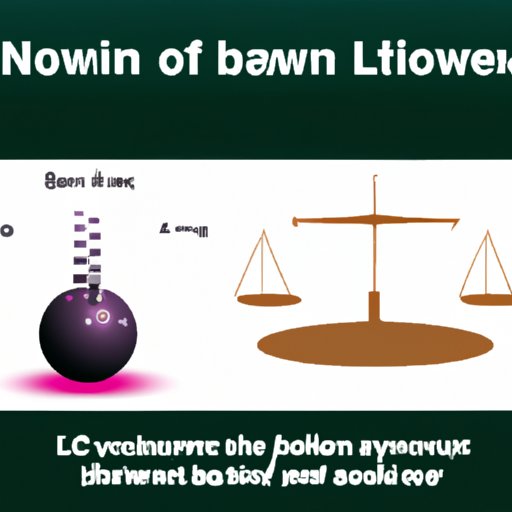Introduction
Science laws are extremely important in the world of science. But what exactly is a science law? This article will explore the different types of science laws, examine some of the most famous science laws, compare them to scientific theories, look at how science laws evolve over time, and consider their impact on society.

Overview of the Different Types of Science Laws
Science laws refer to statements of fact that describe natural phenomena. They are based on observations, experiments, and mathematical calculations. These laws cannot be changed or broken. Science laws are also known as “laws of nature” and are used to explain how the universe works.

Definition of a Science Law
A science law is a universal rule or principle that describes a physical phenomenon or behavior. It is an expression of a relationship between two or more variables. A science law does not provide an explanation for why a phenomenon occurs, but it does provide a way to predict the outcome of an experiment.

Examination of Famous Science Laws
There are many famous science laws that have been studied and accepted by scientists. Some of the most well-known include Newton’s Laws of Motion, Boyle’s Law, and the Second Law of Thermodynamics.
Newton’s Laws of Motion
Isaac Newton developed three laws of motion that explain how objects move and interact with each other. The first law states that an object in motion will stay in motion until acted upon by an outside force. The second law states that the acceleration of an object is directly proportional to the net force acting on it and inversely proportional to its mass. The third law states that for every action, there is an equal and opposite reaction.
Boyle’s Law
Robert Boyle discovered the relationship between the pressure and volume of a gas. This is known as Boyle’s Law. According to this law, when the temperature of a gas is held constant, the volume of the gas is inversely proportional to the pressure applied to it. This means that if the pressure increases, the volume of the gas decreases and vice versa.
The Second Law of Thermodynamics
The Second Law of Thermodynamics states that the total entropy of a closed system always increases. Entropy is a measure of disorder in a system, so this law states that all systems tend towards disorder over time. This law has implications for the study of energy, heat transfer, and chemical reactions.
Comparison Between Science Laws and Scientific Theories
It is important to understand the difference between science laws and scientific theories. While both are based on evidence and observations, they are not the same.
Definitions of Science Laws and Scientific Theories
A science law is a statement of fact about natural phenomena. It is an expression of a relationship between two or more variables. A scientific theory, on the other hand, is an explanation for why a phenomenon occurs. It is based on evidence and observations and is supported by scientific research.
Differences between Science Laws and Scientific Theories
The main difference between a science law and a scientific theory is that a science law is a statement of fact while a scientific theory is an explanation of why a phenomenon occurs. Science laws are based on evidence and observations, but they do not provide an explanation for why a phenomenon occurs. Scientific theories, however, are based on evidence and observations and provide an explanation for why a phenomenon occurs.
How Science Laws Evolve Over Time
Science laws can change and evolve over time as new discoveries are made. New technology and advances in research can lead to changes in existing science laws.
How New Discoveries Lead to Changes in Science Laws
As new discoveries are made, scientists may revise existing science laws or create new ones. For example, Albert Einstein’s Theory of Relativity led to revisions in Newton’s Laws of Motion. New discoveries can also lead to the creation of new science laws. For example, the discovery of quantum mechanics led to the development of the Heisenberg Uncertainty Principle.
How Technology Affects Science Laws
Advances in technology can also lead to changes in existing science laws. For example, the invention of the telescope allowed scientists to observe distant objects in space, which led to the revision of laws such as Newton’s Law of Universal Gravitation. Technology can also help scientists develop new laws or refine existing ones. For example, the development of sophisticated instruments has enabled scientists to make more accurate measurements, which has led to refinements in existing laws such as Boyle’s Law.

Look at How Science Laws are Used in Everyday Life
Science laws are used in everyday life in a variety of ways. Understanding science laws can help us make better decisions about our health, environment, and safety.
Examples of Science Laws in Action
Science laws are used in a variety of ways in everyday life. For example, Newton’s Laws of Motion are used to understand how cars and planes move. Boyle’s Law is used to understand how air conditioners and refrigerators work. The Second Law of Thermodynamics is used to understand how energy is converted from one form to another.
Benefits of Understanding Science Laws
Understanding science laws can help us make better decisions about our health, environment, and safety. For example, understanding the principles of thermodynamics can help us design more efficient engines and machines. Understanding Newton’s Laws of Motion can help us design safer cars and airplanes.
Impact of Science Laws on Society
Science laws have had a tremendous impact on society. They have helped us develop new technologies, understand the natural world, and improve our quality of life.
Positive and Negative Impacts of Science Laws
Science laws have both positive and negative impacts on society. On the positive side, they have helped us develop new technologies and understand the natural world. On the negative side, they can be misused to create weapons of mass destruction or to exploit natural resources.
How Science Laws Help Advance Society
In general, science laws help advance society by providing a better understanding of the natural world. This understanding can lead to new technologies and innovations that improve our quality of life. For example, understanding the principles of thermodynamics has enabled us to develop more efficient engines and machines.
Conclusion
Science laws are an important part of understanding the natural world. They are statements of fact that describe natural phenomena and are usually expressed in terms of relationships between two or more variables. There are many famous science laws, such as Newton’s Laws of Motion and Boyle’s Law, and they can be compared to scientific theories. Science laws can evolve over time as new discoveries are made and technology advances. They are used in everyday life to make better decisions about our health, environment, and safety. Finally, science laws have had a tremendous impact on society, both positive and negative. Understanding science laws can help us advance society and improve our quality of life.
(Note: Is this article not meeting your expectations? Do you have knowledge or insights to share? Unlock new opportunities and expand your reach by joining our authors team. Click Registration to join us and share your expertise with our readers.)
